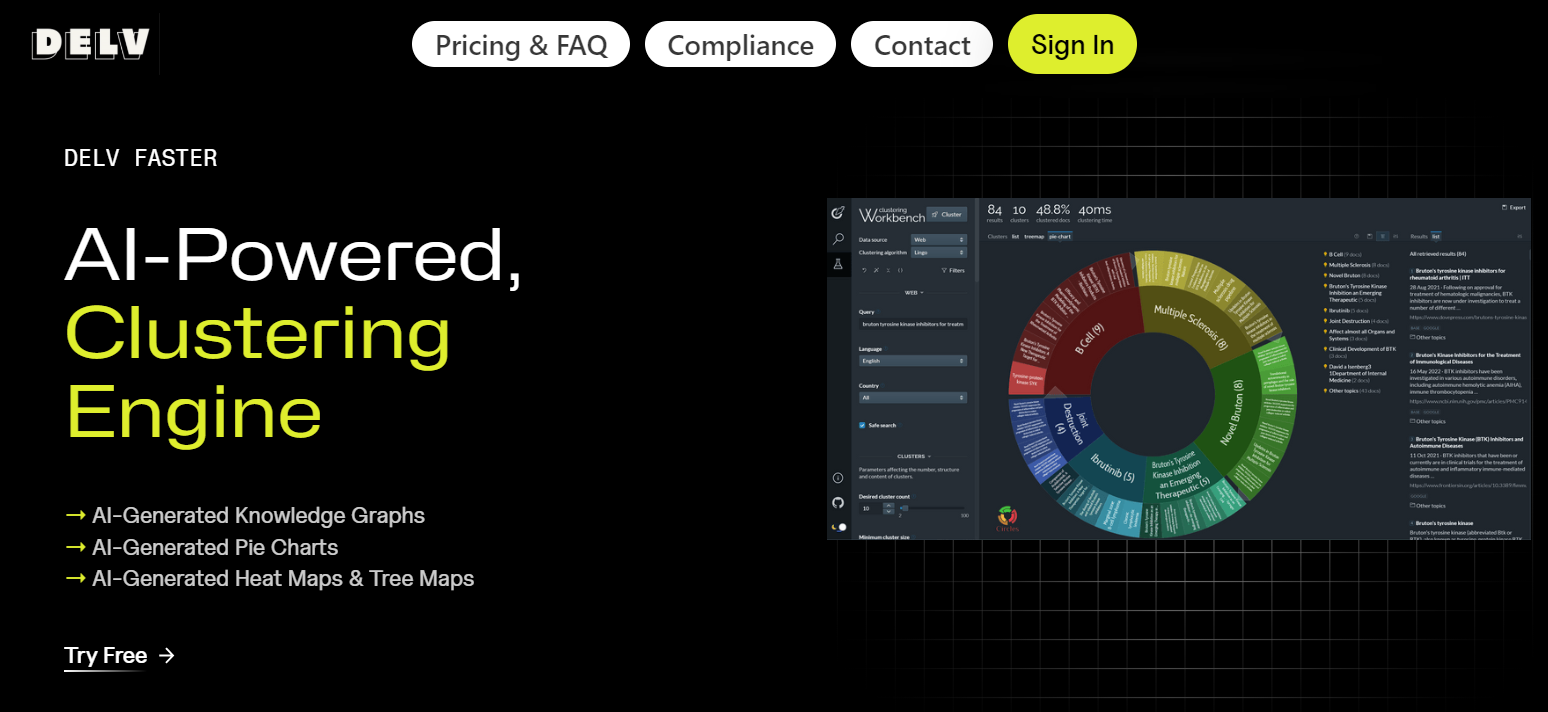Are you tired of spending years on research projects that could be finished in mere months?
Do you wish there was a tool that could not only find the most relevant research for you but also sort, curate, and even read through all those papers?
If you answered “yes” to these questions, then let me introduce you to Delv AI, the research platform that utilizes machine learning to revolutionize your research process.
In this article, we’ll explore the capabilities of Delv AI, breaking down its main features, the clustering search engine and the data extractor.
What is Delv AI?
Delv AI is an advanced research platform that uses AI and machine learning to help researchers find, extract, and analyze information from research papers and documents.
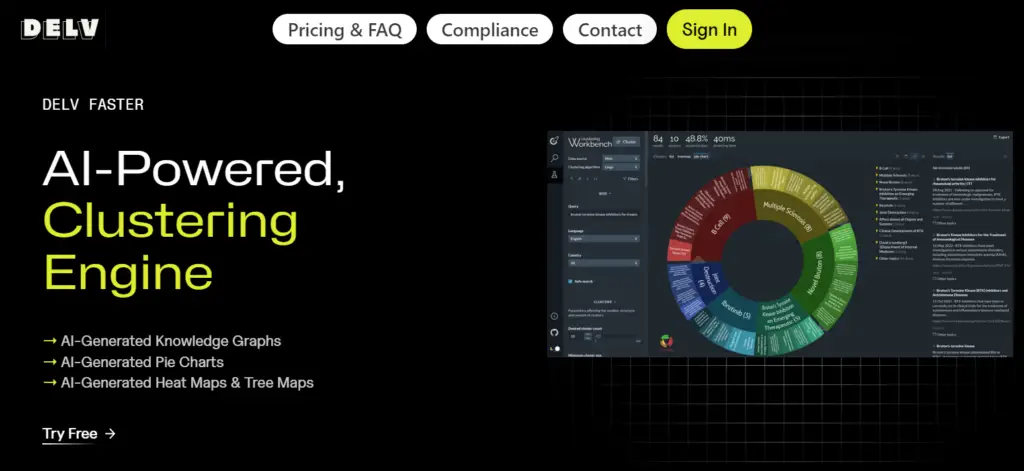
It simplifies and accelerates the research process by offering features like document clustering, data extraction, and question-answering capabilities, making it an invaluable tool for researchers looking to smoothen their work.
Clustering Search Engine: Simplifying Your Search
The first feature of Delv AI is its clustering search engine, a tool designed to make your research more efficient and targeted. Visit here.
Let’s take a closer look at how it works:
1. Query Input
- Begin by entering your research query into the search bar. For example, let’s use the query, “What are the effects of caffeine consumption in children?”
2. Clustering
- Once you’ve entered your query, click on the “Cluster” button. This is where the magic of machine learning comes into play.
3. Machine Learning
- Delv AI’s clustering engine uses machine learning to not only find the most relevant research papers but also categorize them into topics and subtopics, creating a simple interactive pie chart for you to explore.
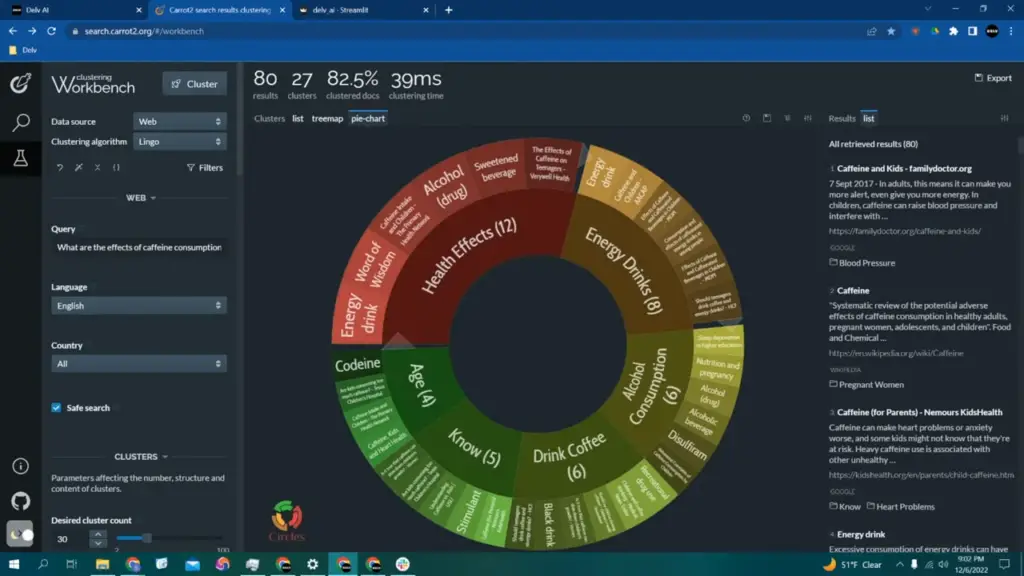
4. Versatile Indexing
- This clustering engine is versatile and can be applied to various types of text-based databases, from clinical trials and research papers to patents and case law. Delv AI doesn’t discriminate when it comes to subjects.
5. Paper Selection
- You can choose a paper that piques your interest, such as “Effects of caffeine and caffeinated beverages in children, adolescents, and young adults.”
6. Extracting Data
- To extract data from the selected paper, you have two options. You can either copy the web link or download the PDF. Let’s go ahead and download the PDF for this example.
Delv AI Data Extractor
With the relevant research papers in hand, it’s time to dig deeper and extract valuable data from them using Delv AI’s second main feature, the data extractor:
1. Query Input
- Just like with the clustering search engine, you begin by entering a query. For instance, “What are the long-term neurological effects of caffeine consumption in children?”
2. Paper Upload
- Upload the paper you’ve chosen to investigate further, either through a web link or, as we did in this example, by uploading a PDF.
3. Machine Learning in Action
- Delv AI’s data extractor quickly processes the paper, reading through its contents and extracting answers directly from the text. It’s like having an AI assistant meticulously comb through research papers, saving you valuable time and effort.
4. Customization
- The best part is that you can tailor the level of information extraction to your needs. Delv AI allows you to control how much data you want to collect from the paper.
5. Mass Extraction
- Perhaps the most time-saving feature of the data extractor is its ability to read an unlimited number of papers simultaneously. This means it can handle a substantial workload, saving your research team thousands of hours annually.
Efficient Research Report Writing
With the research papers selected and all the relevant information extracted by Delv AI, you’re now ready to start writing your research report.
This approach to research not only saves you time but also ensures that you have accurate information.
Delv AI Feature 1: Key Section Context
Unpacking the Key Sections Data Extractor
Delv AI’s Key Sections Data Extractor is a powerful tool that makes it easier for you to extract, view, and understand key sections of research papers.
This feature allows you to gain better context about how these key sections fit into the larger picture of the research paper.
Here’s how it works:
1. Select Your Research Paper
Begin by selecting a research paper relevant to your query.
2. Access Key Sections
Once you’ve selected the paper, the Data Extractor instantly loads the key sections that you previously extracted. You can choose to extract a specific number of key sections, and in this example, we’ll stick with the default of three.
3. Key Section Context
Now, here’s where the new feature comes into play. When you click on each of the key sections, Delv AI will not only display the key section itself but also the preceding and following paragraphs related to that key section.

4. Enhanced Understanding
The preceding paragraph is highlighted in a lighter gray, the key section itself is in a brighter white, and the following key section is also presented in a darker gray.
This layout is designed to provide you with a clearer context about how each key section contributes to the overall content of the research paper.
Improving User Experience
Delv AI is committed to continuously enhancing our platform’s user interface and user experience. This new feature is just the beginning.
We have a lot more in store for 2023, with the goal of making Delv AI even more user-friendly and efficient.
– Scroll View
We’re planning to implement a scroll view on one side of the platform, allowing you to navigate through the entire paper.
As you scroll, you’ll see key sections highlighted and earmarked, making it easier to locate specific information.
– Ongoing Updates
Expect ongoing updates to both our Data Extractor and Clustering Search Engine throughout the year.
These updates will further enhance Delv AI’s usefulness and ease of use, ensuring that your research process is as efficient as possible.
Delv AI Feature 2: Navigating the Knowledge Graph
The Knowledge Graph is a powerful tool designed to help researchers visualize the relationships between various data points and topics within their research.
It’s particularly useful when you want to see how individual data points are connected. Here’s how it works:
1. Choose Your Research Topic
To get started, select a research topic that interests you. In this example, we are exploring “Vector embeddings” using our archive.org clustering engine.
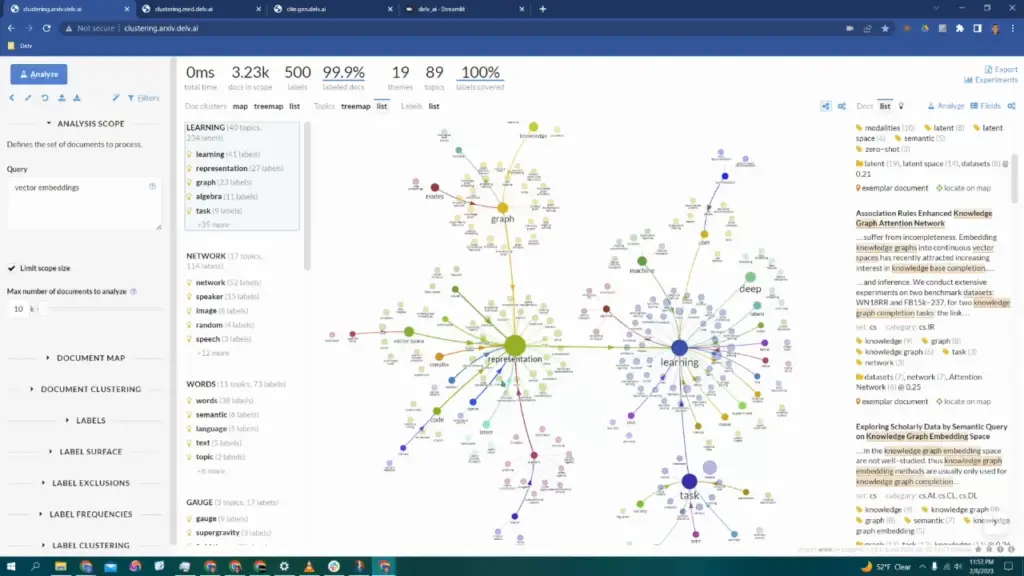
2. Familiar Visualizations
You might already be familiar with our Heat Map and two varieties of Tree Maps. These visualizations provide insights into your research.
The Knowledge Graph is the latest addition to this set of visual aids.
3. Exploring Topics and Labels
The machine learning model breaks down your chosen topic, in this case, “Vector embeddings,” into a series of different topics and labels.
Each of these main topics has an associated Knowledge Graph.
4. Zoom In for Detail
You can zoom in and out to see how each data point is connected to one another within the Knowledge Graph.
This zoom feature helps you visualize the relationships between individual data points clearly.
5. Research Paper Links
On the right side of the Knowledge Graph, you’ll find a list of research papers associated with each of the individual topics and their labels.
This is valuable for researchers who want to explore research papers related to specific data points.
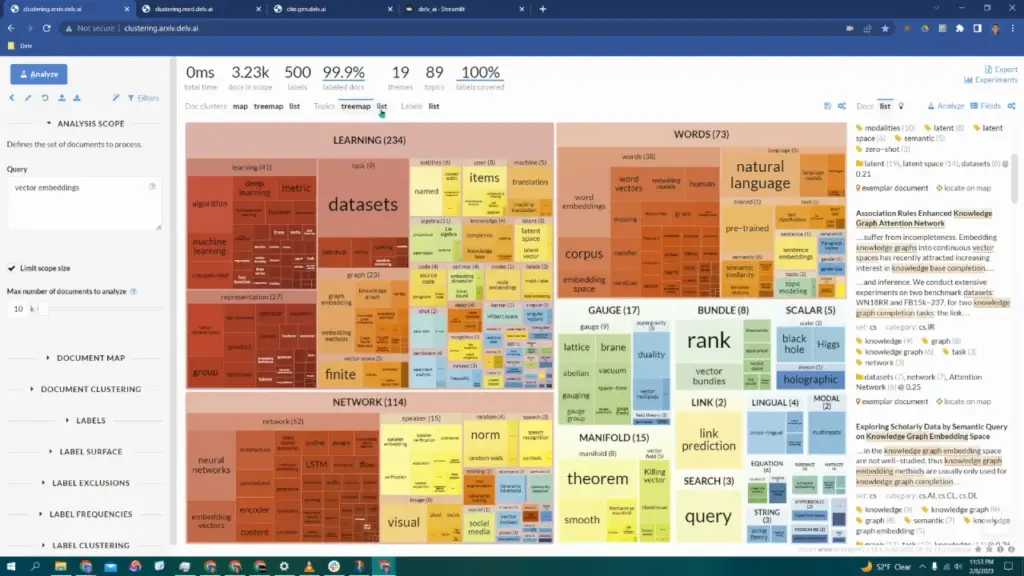
Delv AI Feature 3: Asking Questions
Our new “Ask a Question” feature is designed to simplify your research process by allowing you to pose questions and obtain answers directly from your documents.
It’s a powerful tool that saves you time and effort. Here’s how it works:
1. Input Your Question
Begin by entering your research question into the query box.
2. Upload Your Documents
Delv AI enables you to upload multiple files at once in either TXT or PDF format. If you have several research papers or documents related to your question, this feature can handle them simultaneously.
You can upload up to 20 documents at once.
3. AI-Powered Processing
Once you’ve input your question and uploaded your documents, the AI engine swings into action. It simultaneously accomplishes two vital tasks:
- Key Section Extraction: The AI extracts up to four key sections from your documents, which can provide valuable context and background information relevant to your question.
- Answer Generation: The AI generates a unique answer based on the information contained in the documents you’ve provided.
4. Access Your Answers
The generated answer will be presented to you, providing a clear response to your question.
For instance, the AI may generate an answer like, “The most commonly reported side effects of the COVID-19 vaccine are injection site pain and minor adverse events such as myalgia, body aches, fever, nausea, and vomiting.”
5. Supporting Paragraphs
In addition to the answer, Delv AI also extracts supporting paragraphs from the uploaded documents.
These paragraphs are verbatim from the papers and serve as evidence supporting the generated answer. You’ll find up to four supporting paragraphs aligned with the answer.
6. Unlimited Data Parsing
Delv AI is versatile and can handle an unlimited number of documents, which is ideal for researchers who have a large dataset to parse through. This feature significantly reduces the time and effort required for information extraction.
Conclusion:
In conclusion, Delv AI is an AI tool that simplifies your research projects. You can complete your project task in a few months by using it. You just need to provide the relevant papers and data for your research and the rest of the work Delv AI does for you.
Delv AI is the solution you’ve been looking for to make your research life easier and more productive.
